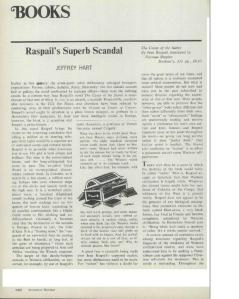I keep hoping someone (ideally a woman) will write an essay on the New Republic and gender. These notes might be useful for that writer and are offered as a spur to thought:
1. On March 1, 1983 Arthur and Cynthia Koestler, a married couple, killed themselves. Beyond the usual ethical questions of suicide, the self-extinction of the Koestlers raised a specifically feminist quandary. Arthur Koestler was 76 when the suicide occurred and facing the onset of Parkinson’s Disease. Suicide was a way of escaping the vulnerability and pain of old age and sickness. His wife was 55 years old and in the bloom of health. Moreover, Arthur, a world-famous novelist, was known to dominate over his meek wife, who served as his secretary. Did Arthur Koestler coerce his wife into suicide? And if so, what ethical judgments do we make of that?
The following year, the New Republic (TNR) commissioned a book review on the writings of Arthur and Cynthia Koestler by Lionel Abel, the literary critic known for his writings on drama. Abel also had a track record of sexism and homophobia. He had earlier written that the ideal theatre critic should be a heterosexual man: “I want a man to go [to the theatre], first of all, not a woman (I do have some prejudices), and I want the man to be stoutly uneffeminate (still more prejudice).” (Although to be fair, “stoutly uneffiminate” could perhaps include butch gay men).
Abel used a literary device to frame his judgement of Arthur Koestler. Abel pretended to be the judges of Hell (“we of Hell”), trying to determine which punishment Koestler deserves. The vast majority of his review is taken up with judging Arthur Koestler on his activities as a communist and anti-communist. But at the beginning Abel makes clear that he (or “we of Hell”) does not hold Koestler responsible for his treatment of Cynthia or any other woman. About Cynthia, Abel writes: “Can you [Arthur Koestler] be condemned for having made life appear so much worth living for Cynthia Koestler that without you her one desire was to die? No, for this you cannot and shall not be blamed by us.”
The paragraph where Abel (“We of Hell”) exonerates Koestler for his treatment of women is worth quoting at in full:
Nor are we concerned about your practices, inveterate, and often regretted infidelities to the women with who you were involved. You were not the master of your appetite for sex, or even for romance. You hurt a lot of women, many of whom had not hurt you. Such are the facts, and in the first two revealing and entrancing volumes of your autobiography, The Invisible Writing and Arrow in the Blue, you admit to this quite candidly. But we of Hell are no feminists, nor are we egalitarian. We think it best for humans if at least half of them are happy, and we do not see why the more joyful ones should not be male.
What do we make of this curious essay, so dismissive of the problem of men who hurt women? A review where there is an implicit connection between men being “more joyful” and hurting women? It shocking to me when I first read it in the October 8, 1984 issue of the New Republic (when I was 17 years old, and hardly a feminist, indeed no more aware of gender justice than most boys my age). It becomes more shocking in retrospect because we know that Koestler’s habit of hurting women extended to assault and rape (there have been several plausible posthumous accusations).
Yet to survey the life of Arthur Koestler, a man already known in 1984 for having troubled relations with women, the New Republic (in the person, I suspect, of literary editor Leon Wieseltier) commissioned a review from a writer known for his neanderthal gender politics.
The whole question of the New Republic and gender is a fraught one, but this review illustrates the problems the magazine often had especially in the three decades after Martin Peretz assumed ownership in 1974.It should be stated first of all that that under the most recent editor, Franklin Foer, who left the magazine last week, greatly improved the magazine’s handling of gender issues, hiring many superb female writers and editors, including the excellent Rebecca Traister, who is a regular columnist.
Yet from the 1970s and to the beginning of the 21st century, TNR had a terrible record on gender issues. It was partially a matter of hirings and assignments. In an article titled “Partisans Reviewed” from the November 1988 issue of Vanity Fair, James Wolcott noted that TNR featured far fewer female bylines than even conservative magazines like National Review or Commentary (which had writers like Jeanne Kirkpatrick, Midge Decter, Gertrude Himmelfarb, Linda Chavez, and others in its stable). Some of those Commentary writers would show up in the New Republic but only occasionally. But beyond not featuring very many women writers and hiring very many women editors, there was a larger question of perspective. Testosterone heavy as it was, the New Republic in the Peretz era was nominally feminist but consistently shunted feminist concerns aside.
2. For a sense of the numbers at work, it’s worth looking at VIDA, a website that usefully tracks bylines by gender. VIDA’s New Republic analysis can be found here. One striking detail: of 59 book reviewers in 2013, only 4 were women. By contrast, the Nation in the same period featured 72 reviewers (53 men, 19 women). The Nation figures aren’t that great but still nearly five times better than the New Republic.
3. “Why pick on the New Republic?” some will ask. “Doesn’t the media as a whole have a gender problem?” Two answers: the New Republic identifies itself as a liberal magazine and since the 1960s (if not before) feminism has been integral to liberalism. But beyond that: the New Republic is a gateway employer. Many of its interns and staffers go on to have jobs at the Washington Post, the New York Times, the New Yorker, and elsewhere. If the media has a gender problem, then the New Republic doesn’t just reflect that problem, it is a causal agent in creating that problem.
4. One paradox is that in the 1980s and 1990s when the New Republic did feature women, they were often very conservative and anti-feminist: Midge Decter, Gertrude Himmelfarb, and Camille Paglia being prime examples. It’s as if the only way a woman could gain entrance to the boy’s club was by denigrating her own sex. Paglia actually wrote perhaps the most vilely sexist piece ever to run in the New Republic, a free-floating exegesis of Hillary Clinton as an “Ice Queen, Drag Queen.” (New Republic, March 2, 1996)
5. Did the New Republic publish exceptional women writers? Sure: Katha Pollitt, Cynthia Ozick, Martha Nussbaum, Margaret
Talbot, Ruth Franklin, and others. That should be acknowledged, even though such names, particularly in the 1980s and 1990s stood out against a masthead and table of contents that looked like a baseball team’s roster.
6. Most of the New Republic‘s editors in the last 40 years would have called themselves feminists if asked — one exception is Fred Barnes, who is an anti-choice evangelical (Episcopalian) Christian (and more recently a Fox News blowhard). Yet their feminism was the most narrowly circumscribed version of liberal feminism: basically support for Roe v. Wade (although even that was often challenged in the magazine’s pages) and little else. Certainly no support for concrete policies to advance substantive equality and no interest in women’s voices (and women’s experiences) as having a valuable perspective not found in male writers.
7. The personal is, as the saying goes, political. One factor behind the New Republic’s gender problem is former owner Martin Peretz’s Harvard fetishism. Peretz used the magazine to create a kind of perpetual dorm room bull session, a place where the guys can talk about the serious issues (what’s wrong with the blacks? what’s wrong with the Palestinians? who should we be bombing now? etc.). Women, almost by definition, don’t belong in a bull session.
8. The New Republic’s gender problem intersected with its race problem. Throughout the 1980s and 1990s, the black mother on welfare occupied a special place in the magazine’s imagination as a prime villain, forever in need of chastisement and discipline lest her profligate ways and out of control fertility destroy the nation. That’s the meaning of this infamous cover.
9. The question of the New Republic and gender tie in with the ongoing reappraisals of the magazine’s legacy. The big claim made on behalf of the New Republic is that it is “liberalism’s central journal.” The question then should be asked, what does it mean for liberalism’s central journal to be so indifferent to feminism?
Post script:
The New Republic returned to the topic of Arthur Koestler’s abuse of women in a review by Tony Judt that ran the February 14, 2000. In that review Judt argues that Koestler’s “sideline” in assault and rape should not effect his standing as a moral hero in the Cold War. To quote Judt: “Reviewers of the English edition of this book have been much taken with the issue of Koestler’s sideline in rape, and have asked how far this should alter posterity’s view of him. But Koestler’s attitude towards women has never been in doubt — you have only to read his memoirs or some of the novels, notably Arrival and Departure. We now know that be raped the wife of a friend and forced his attentions on some reluctant women. This is deeply unattractive behavior. Yet Koestler was no moralist. He did not preach about human goodness or pose himself as an exemplar of anything. If it turned out that he was a closet racist, or had remained all his life a secret member of the Communist Party, or had privately financed violent terrorist organizations, then some of his publications would indeed seem very odd, and we should have to ask how far he wrote in good faith. But nothing he wrote about sex is in contradiction with his actions. And nothing he wrote about politics, or intellectuals, or the death penalty, depends for its credibility upon his sexual behavior.” About this review, all one can say is that women are human, Koestler’s moral standing comes from his writing on human rights, so the fact that he (as Judt acknowledges) raped at least one woman and forced himself on many more has some relevance in judging his status as a moral hero.
In their May 5, 2010 issue, the New Republic published a review of Michael Scammell’s Arthur Koestler biography. The reviewer, Paul Berman, The review is much taken up with the question of whether Koestler was a “hero” or not. It deals with the general abuse of women and rape allegations by not mentioning them. Berman does discuss in the last few paragraphs the double suicide. Berman notes that “domination and dependence” between Koestler and Cynthia might have been behind her joining in the suicide and concludes there was “there was something ghastly about him.”
So: three substantial review essays on Koestler in three decades, none coming to terms with the serious rape allegations and only one coming to terms with the likelihood that Koestler coerced his wife into suicide. And all concerned with Koestler’s heroism. To borrow Berman’s word, this is a ghastly record.
There is a further element of ghastliness to the Koestler business: The most serious, hard-to-refute rape allegation against Koestler was by the late Jill Craigie, who was married to the British politician Michael Foot (himself now deceased). Now, as it happens Foot was a contributor to the New Republic. So this is a rape that doesn’t exist in the abstract, it’s a rape that effected people in the magazine’s extended family. Yet it’s a rape the magazine either pretends didn’t happen or pooh-poohs as a “sideline” (to use Judt’s word).








